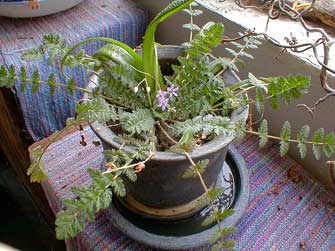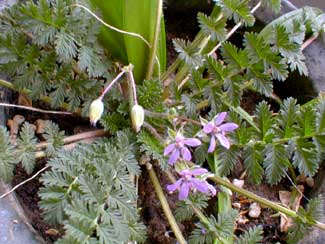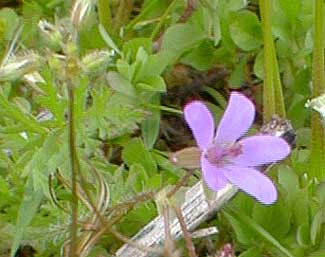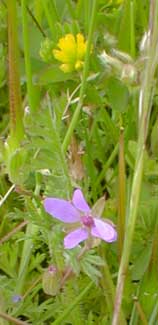
Redstem Filaree,
or Cutleaf Stork's-bill
"A weed is but an unloved flower."
-Ella Wilcox
(1850-1919)
(1850-1919)
Erodium cicutarium is a miniature member of the geranium family that enjoys desert, mesa, rangeland, open meadow, newly tilled ground, & prairie conditions, but is not restricted to these environments as it is highly adaptable. It is often the first & soon dominant weed to establish itself on recently disturbed hillsides or overgrazed pastures, or in fields or grasslands that have been burned. It prefers sandy rocky soils, but also invades lawns.
The first two April photos show a specimen that Granny Artemis & I observed growing with a houseplant, sharing pot space with a heat-loving Lachenalia purpureo-caerulea in a south-facing window. As the lachenalia is just a warty couple of leaves through much of its cycle, & dies back to the top of the bulb for another long patch, it can be quite a boring pot at times, so when this weed began to grow with it, we thought what the heck, it's a nice looking weed.
 In the great outdoors, it is capable of becoming a fabulously aggressive winter annual or biennial, germinating in autumn, flowering as early as February, with rebloom at least until May & occasionally until autumn. In some parts of the United States, it is a harmful invasive pest. Since Puget Sound is a bit wet for it, they are only moderately invasive, liking full-sun under-watered roadside conditions in short grass & poor soil.
In the great outdoors, it is capable of becoming a fabulously aggressive winter annual or biennial, germinating in autumn, flowering as early as February, with rebloom at least until May & occasionally until autumn. In some parts of the United States, it is a harmful invasive pest. Since Puget Sound is a bit wet for it, they are only moderately invasive, liking full-sun under-watered roadside conditions in short grass & poor soil.The third photo is an extreme close up of one of the flowers (much larger than life-size) poking out from among other very short weeds & grasses. The fourth photo additionally captures the flower of another miniscule weed shown larger than life-size, the Least Hops Clover.
Usually prostrate, it is generally no taller than three to six inches, with each leaf up to ten inches long radiating to dinner-plate size from the center, or creeping amidst other small weeds. Under some conditions they do mound upward to a bushier form to ten inches or a foot. The leaves are surprisingly attractive, very feather-like, resembling fern fronds. It might actually be mistaken for a desert fern except that the tiny one-fourth-inch pink-violet flowers eventually give it away as a wild herb.
 Such a widespread weed quite naturally picks up many common names. "Pin Clover" arises from it being as invasive as clover & having pin-like seedpods, hence also the name "Pin Grass" for appearing with its pin-like seeds in grassy meadows & roadsides. These fruits are more often likened to long bird-bills, hence the widespread name Stork's-bill, occasionally Heron's-bill, or even Crane's-bill though this latter is usually reserved for various species of hardy geraniums, rather than for erodiums.
Such a widespread weed quite naturally picks up many common names. "Pin Clover" arises from it being as invasive as clover & having pin-like seedpods, hence also the name "Pin Grass" for appearing with its pin-like seeds in grassy meadows & roadsides. These fruits are more often likened to long bird-bills, hence the widespread name Stork's-bill, occasionally Heron's-bill, or even Crane's-bill though this latter is usually reserved for various species of hardy geraniums, rather than for erodiums.The second-most common name is Filaree, alluding to the filament-like flower stems. There are several variants of, or plays on, the name Filaree, including Alfilaria, perhaps because it so often invades alfalfa crops & it has a homonymous ring to it, echoing Alfalfa.
The name Red-stemmed or Redstem Filaree refers to the same wiry stems that uphold the wee flowers. These stems are frequently maroon for their whole length, or maroon on the upper portion of each flower's stem. But in moist or shady conditions the stems may not be red at all.
 They're least often called "Clocks," I assume due to their growth habit, flat & round with radiating leaves.
They're least often called "Clocks," I assume due to their growth habit, flat & round with radiating leaves.Although it is originally from all around the Mediterranean, it today lives on six continents, & is common throughout the Pacific Northwest states, especially in drier locations than on Puget Sound, but just about everywhere to one degree or another.
It had reached the Pacific Northwest by the 1890s, when pioneer botanist John B. Leiberg (1853-1913) already reported that in the Umatilla River valley, wherever the lands were overgrazed, E. cicutarium displaced native plantlife & became the dominant species. Today when that degree of invasiveness occurs, the filaree tends to dominate only for a couple of years, by which time even more nastily invasive non-native grasses out-compete it.
It came first with the Spaniards to the Americas. The seeds, having corkscrew-tails to them, attached to animals' fur & to the feathers of migratory birds, so that the weed preceded Europeans into as yet unexplored regions. Late in the 1800s when alfalfa was commonly imported from Arabic nations, alfalfa bales were invariably mixed with filaree, so that the act of feeding one's cattle meant that grazing lands were seeded with filaree.
There are some larger, more pleasing species of Erodiums that make good garden plants. The little Redstem Filaree has flowers too tiny to be significant, & its peskiness as an invasive plant is hard to forgive. But periodically there are so many of the teency flowers on the roads that the grass seems to sparkle with violet.